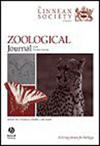Repeated evolution: the case of columellar folds in gastropods
IF 2.8
2区 生物学
Q1 ZOOLOGY
引用次数: 0
Abstract
Most adaptive traits evolved multiple times independently, but the conditions of their evolution remain obscure. Here I examine the origins of columellar folds, spiral ridges on the axial wall of the interior of many gastropod shells, in both extant and fossil gastropods. Analyses indicate that these features arose at least 46 times, primarily in caenogastropods and heterobranchs. Columellar folds do not form in shells in which the coiling axis rises steeply above the apertural plane and in which the rim of the rounded aperture is a logarithmic spiral. More derived clades have shells with a low angle of elevation of the coiling axis, which permits the evolution of a non-circular aperture, a longer columella, and the formation of columellar folds. This architectural predisposition to form folds long preceded the realization of this potential. Functions of columellar folds include reducing apertural access to predators and preventing anteroposterior displacement of soft parts in the shell as parts of the body slide into and out of the shell. These benefits became important late in gastropod history as metabolic rates and activity levels of gastropods and the threat of predation by way of the aperture increased in the later Mesozoic and Cenozoic eras.重复进化:腹足动物小柱褶皱的例子
大多数适应性特征独立地进化了多次,但它们进化的条件仍然不清楚。在这里,我研究了小柱褶皱的起源,许多腹足类动物外壳内部轴壁上的螺旋脊,包括现存的和化石的腹足类动物。分析表明,这些特征至少出现了46次,主要出现在海腹足类和异枝类。如果螺旋轴在孔平面上方陡然上升,且圆形孔的边缘为对数螺旋,则壳体不会形成小柱状褶皱。更多派生枝的壳具有较低的卷曲轴仰角,这允许非圆孔的演化,较长的小柱和小柱褶皱的形成。这种建筑倾向于形成褶皱,早在实现这种潜力之前。小柱褶皱的功能包括减少捕食者的孔道通道,防止身体部分滑入和滑出壳时壳内柔软部位的前后移位。这些优势在腹足类动物历史的后期变得重要,因为在中生代晚期和新生代,腹足类动物的代谢率和活动水平以及通过孔被捕食的威胁增加了。
本文章由计算机程序翻译,如有差异,请以英文原文为准。
求助全文
约1分钟内获得全文
求助全文
来源期刊
CiteScore
6.50
自引率
10.70%
发文量
116
审稿时长
6-12 weeks
期刊介绍:
The Zoological Journal of the Linnean Society publishes papers on systematic and evolutionary zoology and comparative, functional and other studies where relevant to these areas. Studies of extinct as well as living animals are included. Reviews are also published; these may be invited by the Editorial Board, but uninvited reviews may also be considered. The Zoological Journal also has a wide circulation amongst zoologists and although narrowly specialized papers are not excluded, potential authors should bear that readership in mind.

 求助内容:
求助内容: 应助结果提醒方式:
应助结果提醒方式:


